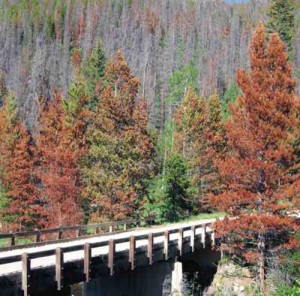Review by Virginia McConnell Simmons
Flora – December 2007 – Colorado Central Magazine
Wildflowers of the Southern Rockies
By Carolyn Dodson and William W. Dunmire
Published in 2007 by University of New Mexico Press
ISBN 0826342442
CHRISTMAS JUST BECAME EASIER for people who have wildflower lovers on their shopping lists. This book will become the favorite of many outdoor enthusiasts who treasure collections of old, tattered guides on their shelves and in their glove compartments or are just getting started with the hobby of wildflower identification. Not only is the taxonomy up to date, but the organization of the book by families is easy for recreational naturalists to deal with. The flowers themselves are easy to recognize with 201 good-sized, four-color photographs and 58 correlated line drawings to assist in identification of plants. In addition, information about such things as habitats, botanists, and cultural lore will provide interesting reading while the recipient awaits the coming of spring blossoms.
The region encompassed by this guide takes in a large swath of mountains from Casper, Wyoming, south to Albuquerque, New Mexico, and from the Front Range west to Grand Junction with elevations between 5,000 to 14,000 feet. Even amateur botanists may quickly recognize that such a large area has more flowering plants, but the text provides the reader with snippets of information about related plants.
As an example, let’s consider the treatment here of the Gentian Family, a favorite of many wildflower sleuths but a confusing one because the various species may look quite different in their diverse habitats. The tall Monument Plant with its light green flowers gets two pages, as do all the other species in this volume. The Monument Plant has two color photos, a written description, and additional paragraphs about the species. The lovely Fringed Gentian, a favorite of many outdoors people with its vivid blue flowers, also has two photos, a written description, discussion about its habitat and natural history, and cultural history, including a paragraph about its medicinal usage, hearkening back to King Gentius of Illyria in the second century B.C. This topic interested me greatly since I once was treated for a strep throat with a purple tincture of gentian back in the dark ages before wonder drugs. (As a remedy, it proved to be only partly efficacious: I lived, but I lost my hearing.)
Or consider the Carrot Family with three species in this volume. Two of them are tall, bushy plants with large, flat umbels of small, white flowers that we might confuse when we are traveling up toward the spruce-fir zone. These are Cow Parsnip with its very large leaves and Osha with its fern-like leaves. The good illustrations in this book will help me separate one from the other in the future. My Hispanic neighbors have known the difference for generations, because, as the text points out, they often used the former, called Yerba del Oso, in medicinal concoctions and tucked the latter into their boots to ward off rattlesnakes.
AS ANOTHER EXAMPLE of the contents of this book, the sizable Lily Family gets ten pages, covering Nodding Onion, Gunnison’s Mariposa Lily, Fawn Lily, Star Solomon’s Seal, and Death Camus, but many more do exist. The text mentions the abundance of other species, but, to learn more about them in our region, you will still want to refer to other guides, such as the old Denver Botanic Gardens’ Meet the Natives, and the even older Field Guide to Rocky Mountain Wildflowers in the Peterson Field Guide Series, or others.
Not surprisingly, guides to wildflowers will often feature different plants in the Lily Family and quite likely some guides will use different common names besides. In other words, the new guide by Dodson and Dunmire was not intended to be definitive nor to replace all the other guidebooks on the bookshelf but will supplement them nicely. For ease of use, attractiveness, and fascinating lore about our common wildflowers, Mountain Wildflowers of the Southern Rockies will be a welcome addition.
Its authors and photographers were well-qualified to compile this book. Carolyn Dodson, retired after a career in library services, holds a master’s degree in biological sciences and teaches wildflower identification classes in the continuing education division of the University of New Mexico. William W. Dunmire served as a naturalist in national parks for many years, has been a field biologist with The Nature Conservancy, and has authored other books about plants in the region. At present, he is an Associate in Biology at the University of New Mexico. The splendid line drawings are the work of the late Walter K. Graf.

